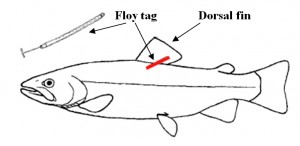Salisbury Angling Club – Trout Stocking Policy
In common with other clubs and following research evidence from the UK and across the world the club has been reducing brown trout stocking in our rivers. This is following both EA and Natural England policy and good practice advocates in the Wild Trout Trust, Salmon and Trout Conservation and other bodies. Early concerns were that stocked trout were reducing our genetic diversity and risking the whole population, less of a concern now that all fish stocked should be triploid (sterile). Experience is that wild populations flourish when stocking is stopped or reduced. Locally many clubs and owners have sought to reduce stocking and in the case of the Wylye the ambition exists to ultimately have full wild status.
Catch Records
S&DAC has catch records going back many years and our rod average has remained the same or improved on all our fisheries. This disguises of course an enormous range of results for individual anglers. Other clubs report similar feedback.
Policy
S&DAC’s policy is to only stock fish in to those areas of our rivers that have the greatest angler pressure and the poorest trout habitat. Durnford, West Amesbury, Abbey, Countess and Stapleford on the Wylye. Stocking reductions started more than ten years ago with some of our beats being designated wild in our year book, e.g. Barford and the Nadder meadows fisheries. More selective stocking on the Avon and other rivers now takes place as we know the stocked fish tend to hold in the poorer areas and we are advised by fishery experts that a difference can be made for the health of wild populations in certain stretches of our rivers.
As things stand now until very major projects can improve some of our poorer habitat we will go on stocking these beats. We stock those beats at intervals dictated by the information we receive from catch returns, electro fishing and observation. The fish are tagged alongside the dorsal fin with a different colour for each season. This helps us keep an eye on numbers caught, killed and gives an indication about survival rates for next seasons. Members should record tagged fish caught in the return books as e.g. Red mark brown trout, RMBT.
Stocking of brown trout has been reduced over the period since 2010 to approximately 33% of what it was at its peak. We expect to stay at about this level until further improvement of the poorer beats is possible. Fish are introduced in the one to two pound range to the beats listed above. Members wanting to take fish for the pot or only interested in fishing for the stocked fish should concentrate on those beats. In some winters a good number survive and provide good early season sport. Members now kill and take only a very small percentage of stocked fish. We do not dictate catch and release but advise that members return all wild untagged fish and take only those with plastic tags.
Less emphasis is now placed on transferring coarse fish from the premium waters to coarse waters. Members are now catching a variety of species on the fly and nymph. Some control of predatory birds and fish will continue.

